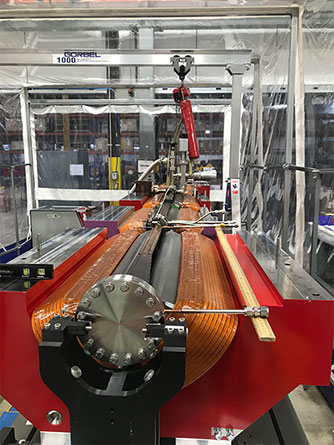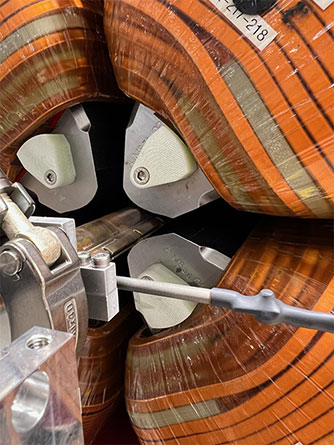Assembling the new storage ring for the Advanced Photon Source (APS), a U.S. Department of Energy (DOE) Office of Science user facility at DOE’s Argonne National Laboratory, is like putting a puzzle together.
This particular puzzle includes 1,321 powerful electromagnets, which need to be assembled into 200 modules. The magnets must be put together in a particular order, and their magnetic centers aligned with each other to within a fraction of the width of a human hair. But it’s not just the magnets. Each module requires several other components, including a complex vacuum system.
Supply chain chain issues associated with the COVID-19 pandemic led to delays, but those vacuum systems are starting to arrive at Argonne.
The first vacuum systems have now been tested and installed. This marks another significant milestone in the assembly process: though the APS Upgrade Project has 185 of the 200 required modules partially put together, they now have two that are substantially completed. More importantly, they have a process to install the rest of the vacuum systems quickly.
“It went easier than we anticipated,” said mechanical engineering specialist Jeremy Nudell of the initial installations. “The vacuum system is well designed. Assembly work went quickly and leaks have not been an issue.”
The vacuum systems are a sequence of long, thin tubes. The system must be pumped down to low pressure levels, comparable to those in outer space. Excessive pressures in the system would lead to stray gas molecules knocking electrons off the beam path, which would limit the lifetime of the beam. To prevent this, the system must be kept clean throughout assembly and leak-tight through all connecting vacuum seals. The new storage ring will increase the brightness of the APS x-ray beams by up to 500 times.
The system is challenging to install, since it has a close clearance with the magnets: about half a millimeter, Nudell said. But he praised the team he works with for learning an intricate skill and executing it.
“Technicians come from all different backgrounds, and some of those backgrounds have nothing to do with particle accelerators,” he said. “During training and qualification, these techs have been eager to learn an unconventional discipline, and they’ve picked it up very quickly. This wouldn’t have been possible without the experience and hard work of the techs and engineers.”
Once the modules are completed, they will go into storage in a facility close to the Argonne campus. When the APS Upgrade installation period begins in April 2023, the facility will shut down for a year. During that time, the original storage ring will be removed and the new one installed, piece by piece. ― Andre Salles
Learn more about the design of the vacuum systems here, and the process of welding them together here.
The Advanced Photon Source is a U.S. Department of Energy Office of Science User Facility operated for the U.S. Department of Energy Office of Science by Argonne National Laboratory under Contract No. DE-AC02-06CH11357
____________________________________________
The U.S. Department of Energy's APS at Argonne National Laboratory is one of the world’s most productive x-ray light source facilities. Each year, the APS provides high-brightness x-ray beams to a diverse community of more than 5,000 researchers in materials science, chemistry, condensed matter physics, the life and environmental sciences, and applied research. Researchers using the APS produce over 2,000 publications each year detailing impactful discoveries, and solve more vital biological protein structures than users of any other x-ray light source research facility. APS x-rays are ideally suited for explorations of materials and biological structures; elemental distribution; chemical, magnetic, electronic states; and a wide range of technologically important engineering systems from batteries to fuel injector sprays, all of which are the foundations of our nation’s economic, technological, and physical well-being.
Argonne National Laboratory seeks solutions to pressing national problems in science and technology. The nation's first national laboratory, Argonne conducts leading-edge basic and applied scientific research in virtually every scientific discipline. Argonne researchers work closely with researchers from hundreds of companies, universities, and federal, state and municipal agencies to help them solve their specific problems, advance America's scientific leadership and prepare the nation for a better future. With employees from more than 60 nations, Argonne is managed by UChicago Argonne, LLC, for the U.S. DOE Office of Science.
The U.S. Department of Energy's Office of Science is the single largest supporter of basic research in the physical sciences in the United States and is working to address some of the most pressing challenges of our time. For more information, visit the Office of Science website.



